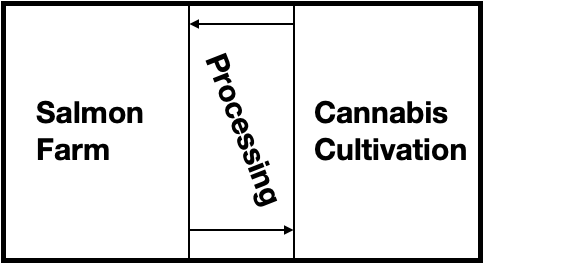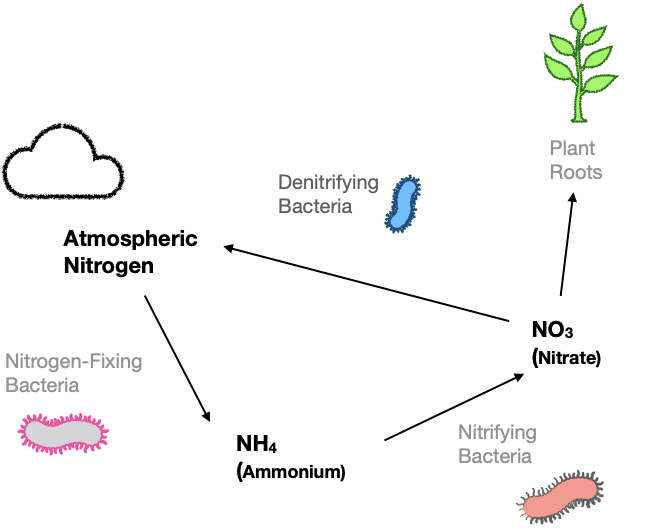
Author’s note: As a personal grower who uses aquaponics on a small scale, I was excited to speak to Rudi Schiebel of Habitat Craft Cannabis about the benefits of the method. -Brad Martin (Pancake Nap)
Rudi Schiebel is a personal grower that uses aquaponics on a small scale at Habitat Craft Cannabis, located in British Columbia. In the first few minutes of our conversation, I learned that Habitat is built around wasting less to produce more.
Structure
Situated on land that also serves an existing bison farm, Habitat Craft Cannabis started cannabis cultivation under an MMAR licence. They built a dedicated structure for cultivation that spanned two rooms. Once they decided to convert to an aquaponic system, they converted one of their two rooms to house the salmon, and created a small area in between the two rooms for the mechanical equipment running the aquaponic system.
Coho Salmon
Rudi explains that the ecosystem at Habitat is based around raising coho salmon that taste great for the consumer. The coho are fed a certified organic, protein-rich biomass through the aquaponic system. As a nutrient source it’s very efficient for the salmon and the system, resulting in a 1:1 uptake – meaning that for every pound that is fed to the salmon, they gain a pound in weight.
The salmon then excrete waste into the water through their gills, 80-90% of which is ammonia. The water the fish live in flows through a circular system that utilizes a natural process called the nitrogen cycle, that feeds the cannabis plants and returns clean water to the salmon. To fully explain how the fish waste is then converted to nutrients that the plant can use, we have to first talk about the intermediate role bacteria plays.
Nitrification
All life on earth relies on a process called nitrogen fixation (Campbell, Reece (2002) Plant Nutrition. Wilson,B. Biology 6th Edition. 774(37)), where atmospheric nitrogen is converted into ammonia by bacteria, referred to as nitrogen-fixing bacteria. Within the soil, nitrogen-fixing bacteria produce ammonium, which is then converted to nitrate by another group of bacteria, known as nitrifying bacteria. The nitrates produced in the soil are then absorbed by plant roots, or returned to atmospheric nitrogen via denitrifying bacteria.
Recirculating Aquaponic System
This nitrifying process is central to Habitat’s aquaponic recirculating system, where it’s used to break down ammonia from the coho salmon into nitrates that are used by the cannabis plants.
As the aquaponic water leaves the salmon tanks, it flows through a drum filter, which removes solids present in the water for mineralization into additional nutrients also required by the cannabis plants. Then the aquaponic water flows to a biofilter, which is where the nitrifying bacteria live and processes the ammonium dissolved in the water to nitrates the plants can use.
Changes in the Ecosystem
All organisms living in Habitat are sensitive to fluctuations in the environment.
Nitrifying bacteria prefer a slightly alkaline pH, but the nitrification evolves hydrogen, which lowers the pH of the water. Many of the nutrients required for plant growth will neutralize the acidic products of nitrification, and are also a requirement for the salmon. Calcium is one of these nutrients, for instance.
Water temperature is also a factor, a large change could disrupt the symbiosis between the three. So, water chillers are also employed to maintain the temperature for both sides.
Deep Water Culture Hydroponics
Once the aquaponic water leaves the biofilter, it is then ready to be taken up by the roots of the plants in Habitat’s habitat. The plants are grown using deep water culture hydroponics, a process where roots of the plants are suspended above an aerated nutrient solution within an enclosed container.
Mycorrhizae, a term for a modified root in symbiosis with fungi, also lives in Habitat, on and within the roots of the cannabis plant. This fungus benefits the plant’s root structure in multiple ways, from aiding in nutrient uptake, to stimulating root growth and providing antibiotic protection. In return, the fungus receives sugars from the host plant and a steady environment to grow in.
Outputs and Benefits
Rudi reports the cannabis flower produced by the system is noticeably different, especially in the visual sense. His flower is testing in the mid 20’s and as high as 28% THC. He also mentions the speed of growth is quick enough to allow for an additional growth cycle a year.
Apart from the dual revenue stream from both salmon and cannabis, there’s also cost savings associated with using this type of system.
“Nutrient production is a carbon intensive process” Rudi says, fertilizer and carbon dioxide don’t need to be purchased or transported; both are provided by the salmon. Through the use of deep-water hydroponics, there is little work required to change the growth medium, which saves on labour costs.
Future Expansion
Rudi also says the aquaponic system is expandable, both in size and also to include processing of other outputs from the cycle happening in the Habitat, such as bio-fuel derived from by-products of harvesting the salmon. They also hope to use their model as a template for similar facilities across Canada and eventually around the world.
A system like the one Habitat uses has potential beyond cannabis. In situations where farmland or water is limited, and in times where demand for food is high, there are advantages to a system that can harness a natural process to regularly produce several sources of food.







































